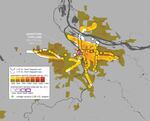Portland is often celebrated as a transit-friendly city, with its mix of light rail, streetcars and frequent bus service. But how does Portland stack up against the transportation systems in other U.S. cities?
Pretty well, actually. That's according to transit planner and public transportation advocate Christof Spieler's new book, "Trains, Buses, People: An Opinionated Atlas of US Transit." It looks at public transit in 47 American cities, pointing out what's working — and, more pointedly, what's not working.
Spieler told OPB “Weekend Edition” host John Notarianni that Portland scores high marks for transit use per capita.
“There’s more transit riders in Portland than other cities that are considerably larger,” Spieler said.
He also commended the frequency of service in much of the city, which he defines as service that comes every 15 minutes or sooner.
“That’s important; that frequent service is the transit that’s there for you when you need it rather than the transit you have to plan your life around,” Spieler said.
He also lauded the Portland aerial tram as being a highly successful transportation option, with extremely high ridership per mile of its operation.
“It’s making a connection that, even though it’s short, is not easily walkable or bikeable,” Spieler said.

The density of Portland's mass transit system, from the book "Trains, Buses, People: An Opinionated Atlas of US Mass Transit."
Christof Spieler
Spieler found fault, however, with the the low-rise, low-density corporate campuses in the Portland’s western suburbs. “These are cases where the fundamental decisions about where to put the jobs are such that it’s really hard for transit to serve that well,” he said.
Looking to Portland’s future, Spieler said the city’s ability to plan for more urban density is more crucial than the plans for specific bus or train lines.
“You can think of every transit stop as having a half-mile or quarter-mile radius and the more stuff there is within them — the more people, jobs, stores and restaurants — the more useful that transit will be to more people,” Spieler said.
Listen to author Christof Spieler's full conversation on OPB's "Weekend Edition" in the audio player above.
